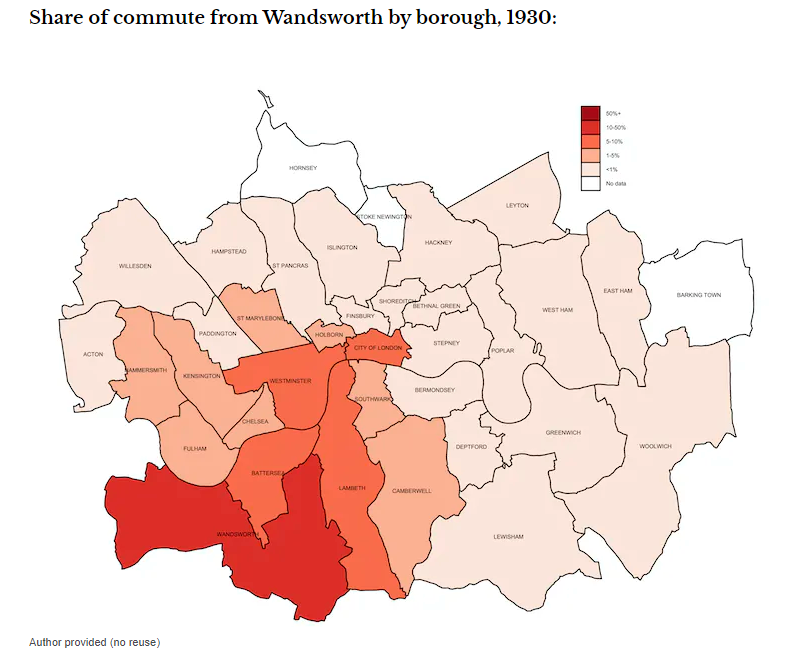September 29, 2022
Public transport makes commuting easier and boosts the labour market
 Following losses of £1.5bn in annual fare revenues incurred during the pandemic, Transport for London recently signed a deal with the UK government for emergency funding. The agreement ensures that new train orders, bridge repairs and tube upgrades will continue as planned. It also will lead to public transport fares rising and bus services being cut. While the Elizabeth Line, a £19 billion east-west addition to the London Underground, opened to great fanfare in May 2022, this year has also seen some of the oldest bus routes in the UK axed: including route 144 between Worcester and Birmingham, route 477 between Dartford and Orpington, and route 84 between north London and Hertfordshire. At least 135 bus routes countrywide currently face cutbacks or permanent cancellation.
Following losses of £1.5bn in annual fare revenues incurred during the pandemic, Transport for London recently signed a deal with the UK government for emergency funding. The agreement ensures that new train orders, bridge repairs and tube upgrades will continue as planned. It also will lead to public transport fares rising and bus services being cut. While the Elizabeth Line, a £19 billion east-west addition to the London Underground, opened to great fanfare in May 2022, this year has also seen some of the oldest bus routes in the UK axed: including route 144 between Worcester and Birmingham, route 477 between Dartford and Orpington, and route 84 between north London and Hertfordshire. At least 135 bus routes countrywide currently face cutbacks or permanent cancellation.
The standard justification for public transport closures is economic feasibility – a lack of profitability for the service provider. As our work shows, however, such discussions often miss much of the full value of public transport to society. In addition to making profits for operators, public transport opens up labour market opportunities for workers, increases residential choice, and reduces crowding in inner-city areas.
Our research examines the consequences of working-class access to public transport in London in the 1920s and 1930s. We know from a survey of working-class London conducted in the 1890s, entitled The Life and Labour of the People of London, that Victorian-era workers were typically employed in the immediate area of their home. Indeed, the homes themselves were often extensions of factories as “outwork” was a common phenomenon.
This absence of commuting in the 19th century led to widespread urban crowding, as industry typically clustered geographically due to economies of scale and agglomeration. Social reformers commented on how crowding caused poverty and what they perceived to be “vice”, as well as the spread of diseases.
Over the next 40 years, growth of the transport networks opened up opportunities for working-class commuting. By 1930, most residents and workers in the north and west of London had access to the Underground, most in the south and east had access to a tram, and almost everyone had access to at least one bus route. Only 1% of Londoners lived more than 560 metres from a public transport stop.
We have used the New Survey of London Life and Labour, a 1930 follow-up survey which contains a large sample of working-class Londoners, to examine how early public transport networks affected the labour market. This data contains, among other things, each worker’s place of residence and work.
By “GIS coding” this information, along with the entire extant public transport system in the London area, we were able to calculate their commuting distances, the centrality of their residences and workplaces, and their access to public transport.
Our research shows that commuting in 1930 followed many of the same patterns as today. The largest number of workers (about 38%) commuted inwards towards the city centre. The next-largest group (29%) worked within a kilometre of their residence. The remaining workers were evenly split between people travelling away from the centre for work and others travelling across the city.
To illustrate the typical commuting patterns, let’s look at where residents of Wandsworth Borough, located about nine kilometres southwest of the city centre, commuted for work.
We found that the average residence had 212 employers (in any industry) within a one-kilometre radius, 1,700 within three, and 4,333 within five. Moreover – holding age, gender, occupation and workplace area as constants – an additional kilometre commuted increased earnings by 1.5% to 3.0%, although the additional returns on longer commutes were likely less. These higher earnings considerably outweighed the monetary cost of public transport.
Access to transport leads to increased job opportunities
To understand the importance of public transport networks to labour markets, it is necessary to understand the reasons behind these large returns to commuting. We focus on two explanations why a commuting worker might have earned more than a local worker.
Search theory suggests that individual workers are better suited to some employers than others. Someone who can only work near to home, as was typical for workers in the Victorian period, only has a small number of employers to choose from.
But a worker who can travel using public transport, as had become the norm by 1930, can potentially work for more different employers. This in turn implies there will be a higher probability of a good match between workers and employers, and thus higher productivity and wages.
In the 1930s, British economist Joan Robinson in her book The Economics of Imperfect Competition formulated a theory of microeconomics she called monopsony. A slightly modified version of this theory suggests that, in the absence of public transport, local employers have a degree of monopoly power over their workers.
Employers can pay less than the market wage because it is costly for workers to switch to more distant jobs. The construction of London’s public transport networks in the early 20th century opened up remote employment opportunities for workers, and thus reduced local employers’ monopoly power.
Public transport improvements between 1890 and 1930 broke the link between residence and workplace. This allowed first the middle class and then the working class to move away from the city centre.
One result was a dramatic decrease in urban crowding and the associated concentration of poverty and spread of disease. As we have shown in our research, another implication was that workers were no longer constrained to working locally, and could seek out better employment opportunities further form home. This led to substantially higher wages for the working class of London.
These lessons about public transport from the 1930s still resonate today. If historical improvements in public transport increased the efficiency of London’s labour market, more recent cuts to infrastructure and increases in ticket prices will likely have the opposite effect. Workers who are no longer able to commute large distances or who face higher costs of doing so will likely also face a restricted set of employment opportunities.
Andrew J. Seltzer is Professor of Economics and Economic History, Royal Holloway University of London. Jonathan Wadsworth is Professor of Economics, Royal Holloway University of London
This article is republished from The Conversation under a Creative Commons license. Read the original article.














